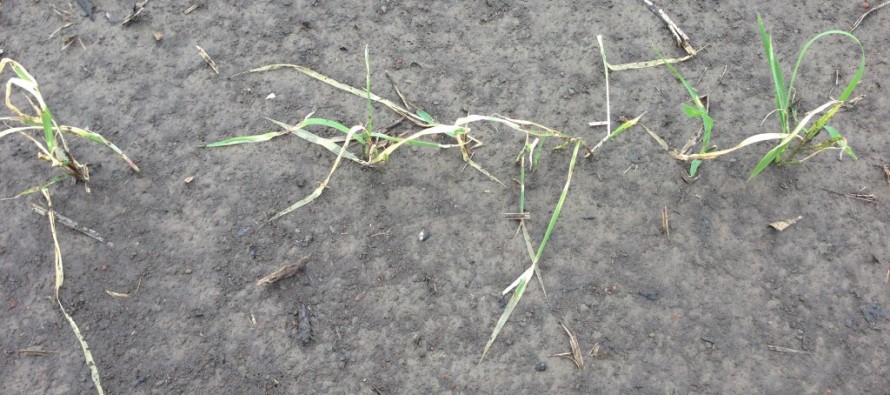Off-target Herbicide Movement to Rice

Glyphosate-resistant weeds, primarily glyphosate-resistant Palmer amaranth, are the principal weed control issue facing growers in Mississippi. Rice is indirectly affected by glyphosate resistance through off-target movement of herbicides targeting these weeds in adjacent fields. Off-target herbicide movement has always been a concern for rice growers. Previous research in Mississippi and other states has thoroughly evaluated the rice response to simulated drift of different herbicides, primarily glyphosate. Mississippi State University Extension Service recommendations are to apply paraquat (Gramoxone SL, Parazone, Firestorm, etc.) mixed with a residual herbicide to control glyphosate-resistant weeds prior to planting corn, cotton, or soybean. Unfortunately, cases of off-target movement of paraquat to rice have increased in Mississippi in recent years.
A study conducted in 2013 at the Mississippi State University Delta Research and Extension Center showed that rice yield was reduced with Reflex and Metribuzin applied prior to flooding at 25% of the use rates. Gramoxone SL reduced rice yield when applied prior to flooding at 12.5 and 25% of the use rate.
A follow up study in 2014 evaluated the effect of low rates of Gramoxone SL and Reflex applied at different application timings. Simulated drift applications were made at 25% of the use rates of Gramoxone SL (3 pints/A) and Reflex (1 pint/A). These treatments were applied very early-postemergence (VEPOST) to rice in the one-leaf stage, early-postemergence (EPOST) to rice in the two- to three-leaf stage, mid-postemergence (MPOST) to rice in the three- to four-leaf stage, late-postemergence (LPOST) to rice in the four-leaf to one-tiller stage, or 21 d after flooding (21 d PTFLD).
At 14 days after treatment (DAT), rice injury with Gramoxone SL was greatest from EPOST applications and least from applications 21 d PTFLD. Preflood applications of Gramoxone SL applications delayed rice maturity, but rice treated with Gramoxone SL 21 d PTFLD never fully matured. All applications of Gramoxone SL reduced rice yield ≥13% with similar reductions following preflood applications. Gramoxone SL applications after flooding reduced rice yield 84%.
Rice injury 14 DAT with Reflex was <15% regardless of application timing. Reflex applications only influenced rice heading when applied 21 d PTFLD, and the delay following this application was only 1 day. Rice yield was not reduced following applications of Reflex VEPOST, EPOST, or MPOST; however, Reflex applied LPOST and 21 d PTFLD reduced rice yield 12 and 36%, respectively.
Based on injury 14 DAT and rice maturity, Gramoxone SL applications were more damaging to rice than Reflex. Rice recovered from early-season injury following simulated drift of Reflex with no reductions in yield following applications VEPOST, EPOST, or MPOST. Although the magnitude varied, yield reductions were greatest with either herbicide applied 21 d PTFLD. Yield reductions following 21 d PTFLD applications of Gramoxone SL and Reflex were 84 and 36%, respectively. Problematically, the greatest visual injury 14 DAT from these applications was 28% with Gramoxone SL. Therefore, when off-target movement of these herbicides occurs at midseason, the full extent of the consequences may not be apparent until harvest. Previous research has shown this to also be the case with drift of glyphosate and Liberty 280.
Paraquat-based herbicide applications are vital to weed control in Mississippi; however, off-target movement of these treatments is common on most crops across the Delta where problems with glyphosate-resistant weeds are most intense. For rice, the magnitude of damage from off-target movement of a paraquat-based herbicide application depends on the dose that moves to the rice and the growth stage at the time of the off-target event. As rice approaches reproductive growth stages, it is less likely to recover from injury due to off-target herbicide movement. Furthermore, when off-target movement occurs during preflood rice growth stages, additional management in the form of additional herbicide or fertilizer applications and/or altered water management is nearly always required.






Let me tell You a sad story ! There are no comments yet, but You can be first one to comment this article.
Write a comment